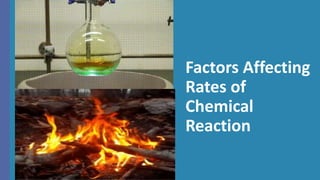
Factors-Affecting-Rates-of-Chemical-Reaction (1).pptx
- 2. • To a scientist, a reaction rate means how quickly or slowly a reaction takes place. • Scientific studies have shown that there are five factors that affect reaction rates. • They are temperature, concentration, surface area, the presence of a catalyst and the nature of the reactants. 2
- 3. Temperature • Temperature is the measure of the kinetic energy, or energy of motion, in the particles of a substance. • As temperature increases, the particles move faster and come in contact more often. • In order for two substances to react, the particles of those substances must collide with each other. • For example: Foods cook slowly at low temperatures than at high temperatures. 3
- 5. Surface Area • For a reaction to occur, substances must come in contact with each other. • Contact can only take place at the surfaces of the substances involved in the reaction. • As the surface area increases, the rate of a reaction increases because more particles can come together. • The surface area of reactants affects the rate of reaction. If the size of a particle is small, the surface area will be more and this increases the speed of heterogeneous chemical reactions. 5
- 7. Concentration • Concentration tells us how much solute there is in a solution. As the concentration of the chemical increases, the chance of contact among particles also increases. • This causes an increase in the rate of reaction. • According to collision theory, the greater the number of molecules the higher is the collision ratio, thus the rate of reaction is faster. 7
- 8. 8
- 9. Catalysts • A catalyst is a substance that changes the rate of a chemical reaction by providing an alternate pathway, lowering the activation energy. • Most catalysts speed up reactions but they are not changed or used up in a reaction. • They are the same at the beginning and end of the reaction. • Enzymes are considered as catalysts to speed up the biochemical reactions in the body. 9
- 10. Application of the Factors Affecting Rate of Reaction 10
- 11. 1. Food and Pharmaceutical products preservation • Temperature is a very essential factor in preserving foods and medicines. • High temperatures cause higher collision and reactions produce by microorganisms that are why most of food medicinal products are stored in low temperatures. 11
- 12. 2. Preservation or decomposition of specimens • Biochemical laboratories make use of liquid nitrogen as cryogenic freezer in preserving laboratory sample and specimens. • This process is called cryopreservation where cells or whole tissues are preserved by cooling to low sub-zero temperatures. • At low temperatures, any biological activity, including the biochemical reactions that would lead to cell death, is effectively stopped. 12
- 13. 3. Medication or poison affecting the body • It is essential to know the right concentration of the drugs that we take. • Some drugs are more effective if taken in higher concentrations. There are also drugs that may poison our bodies if we take an amount more than the prescribed concentration. 13
- 14. 4. Dating, restoration, preservation of artifacts • To preserve wood and leather artifacts, these must be soaked in polyethylene glycol. • Polyethylene glycol is a waxy substance that is absorbed into wood and leather and makes wood stronger and makes leather flexible again. 14